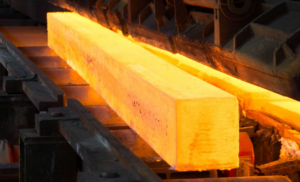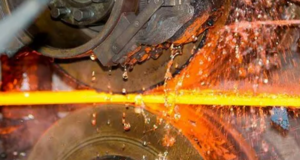What’s the hot rolling process of stainless steel?
The hot rolling process of stainless steel refers to rolling the steel ingot above the recrystallization temperature, while cold rolling refers to rolling the steel ingot below the recrystallization temperature. Simply put, hot rolling involves heating the steel ingot and then rolling it through several passes before being trimmed into a steel plate. This can significantly reduce energy consumption and costs. That is because, during the hot rolling process, metal has high plasticity and low deformation resistance, so the energy consumption for metal deformation can be greatly reduced.

The hot rolling process of stainless steel can improve the processing properties of metals and alloys, namely by breaking coarse grains in the as-cast state, healing cracks, reducing or eliminating casting defects, and transforming the as-cast microstructure into a deformed one to improve the processing properties of the alloy.
Hot Rolling Concept and Characteristics
(1) Concept
Hot rolling refers to the rolling process carried out above the recrystallization temperature of the metal.
Recrystallization refers to the process where when the annealing temperature is high enough and the time is long enough, new grains (recrystallized grains) that are not stressed are generated in the fiber structure of the deformed metal or alloy. These new grains continue to grow until the original deformed structure disappears completely, and the metal or alloy properties also change significantly. This process is called recrystallization.
The temperature at which new grains begin to form is called the initial recrystallization temperature. The temperature at which the microstructure is completely occupied by new grains is called the final recrystallization temperature. Generally, the recrystallization temperature refers to the arithmetic average of the initial recrystallization temperature and the final recrystallization temperature. The recrystallization temperature is mainly affected by factors such as the alloy composition, deformation degree, original grain size, and annealing temperature.

(2) Characteristics of Hot Rolling
- Low energy consumption, good plasticity, and low deformation resistance, the phenomenon of work hardening is not obvious, and rolling is easy to carry out, which reduces the energy consumption of metal deformation.
- Hot rolling usually uses large ingots under high pressure and high rolling speed, resulting in fast production and high yield, paving the way for large-scale production.
- Through hot rolling, the cast structure is transformed into a processed structure, which greatly improves the plasticity of the material.
- The characteristics of the rolling method determine the anisotropy of the rolled sheet. Firstly, there are significant differences in performance between the longitudinal, transverse, and height directions of the material. Secondly, there are deformation textures and recrystallization textures, which result in significant directionality in the stamping performance.
Advantages and Disadvantages of Hot Rolling
(1) Advantages
① Hot rolling can significantly reduce energy consumption and lower costs. The metal has high plasticity and low deformation resistance during the hot rolling process, greatly reducing the energy consumption of metal deformation.
② Hot rolling can improve the processing performance of metals and alloys, i.e., the coarse grains in the cast state are broken up, cracks heal, and casting defects are reduced or eliminated. The cast structure is transformed into a deformed structure, thereby improving the processing performance of the alloy.
③ Hot rolling usually uses large ingots with high pressure and large reduction in rolling, which not only improves production efficiency but also creates conditions for increasing rolling speed and achieving continuous and automated rolling.
(2) Disadvantages
① After hot rolling, non-metallic inclusions (mainly sulfides, oxides, and silicates) in the steel are pressed into thin layers and undergo delamination (layers). Delamination severely deteriorates the tensile property of the steel in the direction of thickness and can also cause the risk of interlaminar tearing when the welding seam contracts. Local strain caused by welding seam contraction usually reaches several times the strain at yield point, much higher than the strain caused by load.
② Residual stress caused by uneven cooling. Residual stress is an internal self-balancing stress without external force. All hot-rolled steels of various sections have such residual stress. Generally speaking, the larger the section size of the steel, the larger the residual stress. Although residual stress is self-balancing, it has a certain impact on the performance of steel components under external forces, such as deformation, stability, fatigue, etc.
③ Hot rolling cannot accurately control the mechanical properties required by the product. The organization and performance of hot-rolled products are difficult to be uniform. The strength index is lower than that of cold-worked and hardened products but higher than that of fully annealed products. The plasticity index is higher than that of cold-worked and hardened products but lower than that of fully annealed products.
④ Hot rolling product thickness control is difficult with poor control accuracy; hot rolling surface roughness Ra value is usually 0.5 to 1.5 μm higher than cold rolling surface roughness Ra value. Therefore, hot-rolling products are usually used as cold-rolling blanks.
Application of Hot-rolled Products
- General structural steel, engineering hot-rolled steel plates and steel strips;
- Welded pipes, cold-rolled materials, bicycle parts, and important welding, riveting, and bolting components.
- Cold rolled and deep drawn products.
- Stamping parts and structural parts for automobiles, tractors, engineering cranes, and small light industrial machinery.
- Vessels and bare metal structural components.
- Pipelines for transporting oil and natural gas.
- Frame and crossbeam.
- Steel strip for automobile wheels.
- Industrial skateboards, stairs, ladder treads, etc.
Why Choose Sino Stainless Steel?
Thank you for reading our article and we hope it can help you to have a better understanding of the hot rolling process of stainless steel. If you are looking for suppliers and manufacturers of hot-rolled stainless steel, we’d advise you to visit Sino Stainless Steel.
As a leading supplier of hot-rolled stainless steel across the world, Sino Stainless Steel provides customers with high-quality Stainless Steel Angles, Stainless Steel Channels, 201 Stainless Steel Strips & 304 Stainless Steel Strips, 409 Stainless Steel, 316 and 316L Stainless Steel, Stainless Steel Hexagon Bars, Hot-rolled Stainless Steel, Colored Stainless Steel Sheets, Stainless Steel Perforated Sheets, Cold-rolled Precision Stainless Steel, Stainless Steel Wire, and Embossed Stainless Steel Plates.
 :+86-13012867759
:+86-13012867759  :export86@sino-stainless-steel.com
:export86@sino-stainless-steel.com